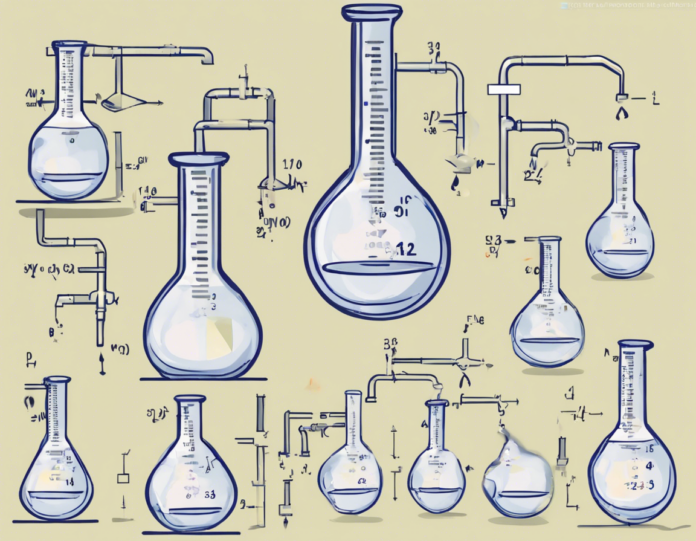Understanding the concept of molarity is crucial in the field of chemistry, especially when dealing with solutions. Molarity is defined as the number of moles of solute per liter of solution. It is represented by the symbol “M” and is expressed in units of moles per liter (mol/L). When calculating the molarity of a solution, it is essential to consider the amount of solute dissolved in the solvent.
In this article, we will focus on the calculation of the molarity of ethanol in a water solution. Ethanol, also known as ethyl alcohol, is a common organic solvent that is miscible in water. When ethanol is dissolved in water, it forms a homogeneous mixture where ethanol molecules are evenly distributed in the water.
To calculate the molarity of ethanol in a water solution, we need to know the following information:
- The moles of ethanol present in the solution.
- The volume of the solution in liters.
Let’s walk through the steps involved in calculating the molarity of ethanol in a water solution:
Step 1: Determine the Moles of Ethanol
The first step is to determine the moles of ethanol present in the solution. This can be done using the formula:
[ \text{moles} = \frac{\text{mass of ethanol (g)}}{\text{molar mass of ethanol (g/mol)}} ]
For example, if we have 30 grams of ethanol and the molar mass of ethanol is 46.07 g/mol, the calculation would be:
[ \text{moles of ethanol} = \frac{30 \text{ g}}{46.07 \text{ g/mol}} ]
Step 2: Determine the Volume of the Solution
Next, we need to determine the volume of the solution in liters. This can be done by measuring the volume of the solution using a graduated cylinder or volumetric flask.
Step 3: Calculate the Molarity
Once we have the moles of ethanol and the volume of the solution, we can calculate the molarity using the formula:
[ \text{Molarity (M)} = \frac{\text{moles of ethanol}}{\text{volume of solution (L)}} ]
Substitute the values into the formula to get the molarity of ethanol in the solution.
Example Calculation
Let’s consider an example where we have 0.5 moles of ethanol dissolved in 2 liters of water. To calculate the molarity of ethanol in the solution:
[ \text{M} = \frac{0.5 \text{ moles}}{2 \text{ L}} = 0.25 \text{ M} ]
Therefore, the molarity of ethanol in the solution is 0.25 M.
Factors Affecting Molarity Calculation
It is essential to note that the accuracy of the calculated molarity depends on the precision of the measurements taken. Ensure you have the correct mass of solute, accurate molar mass, and precise volume of the solution.
Dilution and Molarity
When diluting a solution with water, the moles of solute remain constant while the volume of the solution increases. Therefore, dilution does not affect the molarity of the solute. The molarity is a concentration value that remains constant regardless of the volume changes due to dilution.
Common Mistakes in Molarity Calculations
-
Incorrect molar mass: Using the wrong molar mass for the solute can lead to inaccurate molarity calculations.
-
Volume in incorrect units: Ensure the volume of the solution is in liters when calculating molarity to maintain consistency with the unit of molarity (mol/L).
-
Rounding errors: Avoid rounding off intermediate values during calculations to minimize errors in the final molarity result.
Applications of Molarity in Real Life
Molarity is a critical concept used in various fields, such as:
-
Pharmaceuticals: Determining the concentration of active pharmaceutical ingredients in medications.
-
Environmental Science: Analyzing pollutant concentrations in water samples.
-
Food Industry: Measuring the sugar content in beverages.
By understanding how to calculate molarity, individuals can make informed decisions regarding solution concentrations in different applications.
FAQs on Calculating the Molarity of Ethanol in Water Solution
1. Can I use any units for molarity calculations?
- The standard unit for molarity is moles per liter (mol/L); therefore, ensure all values are in the appropriate units for accurate calculations.
2. How do I convert grams to moles for molarity calculations?
- Use the formula: moles = mass (g) / molar mass (g/mol) to convert grams of solute into moles.
3. Is the volume of solute included in the volume of the solution for molarity calculations?
- No, only the volume of the solvent (usually water) should be considered when calculating the molarity of a solution.
4. What is the significance of molarity in stoichiometry calculations?
- Molarity is crucial in stoichiometry as it helps determine the amount of substance needed for a chemical reaction based on the molar ratios of reactants and products.
5. Can I calculate molarity if the solution is not homogeneous?
- Molarity calculations are based on the assumption of a homogeneous solution, where the solute is uniformly distributed in the solvent.
In conclusion, understanding how to calculate the molarity of ethanol in a water solution is fundamental in chemistry and various scientific disciplines. By following the steps outlined and avoiding common mistakes, individuals can accurately determine the concentration of solutes in solutions, enabling them to perform experiments and analyses with precision.

